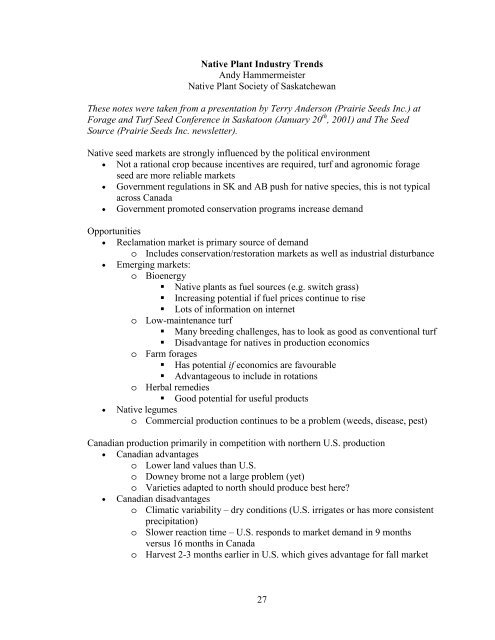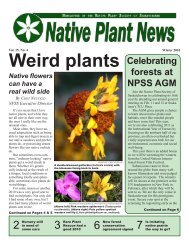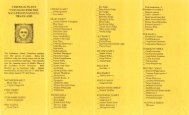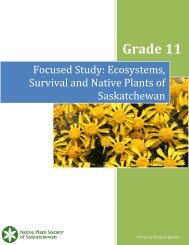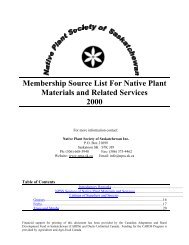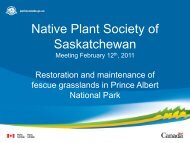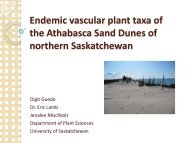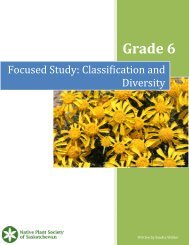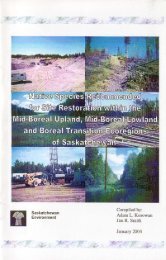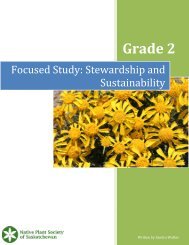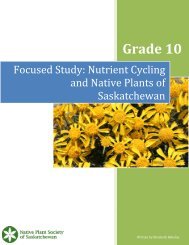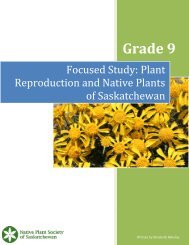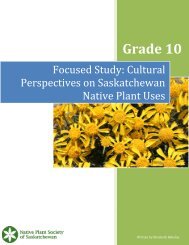Native Plants As Habitat For Wildlife - Native Plant Society of ...
Native Plants As Habitat For Wildlife - Native Plant Society of ...
Native Plants As Habitat For Wildlife - Native Plant Society of ...
Create successful ePaper yourself
Turn your PDF publications into a flip-book with our unique Google optimized e-Paper software.
<strong>Native</strong> <strong>Plant</strong> Industry Trends<br />
Andy Hammermeister<br />
<strong>Native</strong> <strong>Plant</strong> <strong>Society</strong> <strong>of</strong> Saskatchewan<br />
These notes were taken from a presentation by Terry Anderson (Prairie Seeds Inc.) at<br />
<strong>For</strong>age and Turf Seed Conference in Saskatoon (January 20 th , 2001) and The Seed<br />
Source (Prairie Seeds Inc. newsletter).<br />
<strong>Native</strong> seed markets are strongly influenced by the political environment<br />
• Not a rational crop because incentives are required, turf and agronomic forage<br />
seed are more reliable markets<br />
• Government regulations in SK and AB push for native species, this is not typical<br />
across Canada<br />
• Government promoted conservation programs increase demand<br />
Opportunities<br />
• Reclamation market is primary source <strong>of</strong> demand<br />
o Includes conservation/restoration markets as well as industrial disturbance<br />
• Emerging markets:<br />
o Bioenergy<br />
# <strong>Native</strong> plants as fuel sources (e.g. switch grass)<br />
# Increasing potential if fuel prices continue to rise<br />
# Lots <strong>of</strong> information on internet<br />
o Low-maintenance turf<br />
# Many breeding challenges, has to look as good as conventional turf<br />
# Disadvantage for natives in production economics<br />
o Farm forages<br />
# Has potential if economics are favourable<br />
# Advantageous to include in rotations<br />
o Herbal remedies<br />
# Good potential for useful products<br />
• <strong>Native</strong> legumes<br />
o Commercial production continues to be a problem (weeds, disease, pest)<br />
Canadian production primarily in competition with northern U.S. production<br />
• Canadian advantages<br />
o Lower land values than U.S.<br />
o Downey brome not a large problem (yet)<br />
o Varieties adapted to north should produce best here<br />
• Canadian disadvantages<br />
o Climatic variability – dry conditions (U.S. irrigates or has more consistent<br />
precipitation)<br />
o Slower reaction time – U.S. responds to market demand in 9 months<br />
versus 16 months in Canada<br />
o Harvest 2-3 months earlier in U.S. which gives advantage for fall market<br />
27


